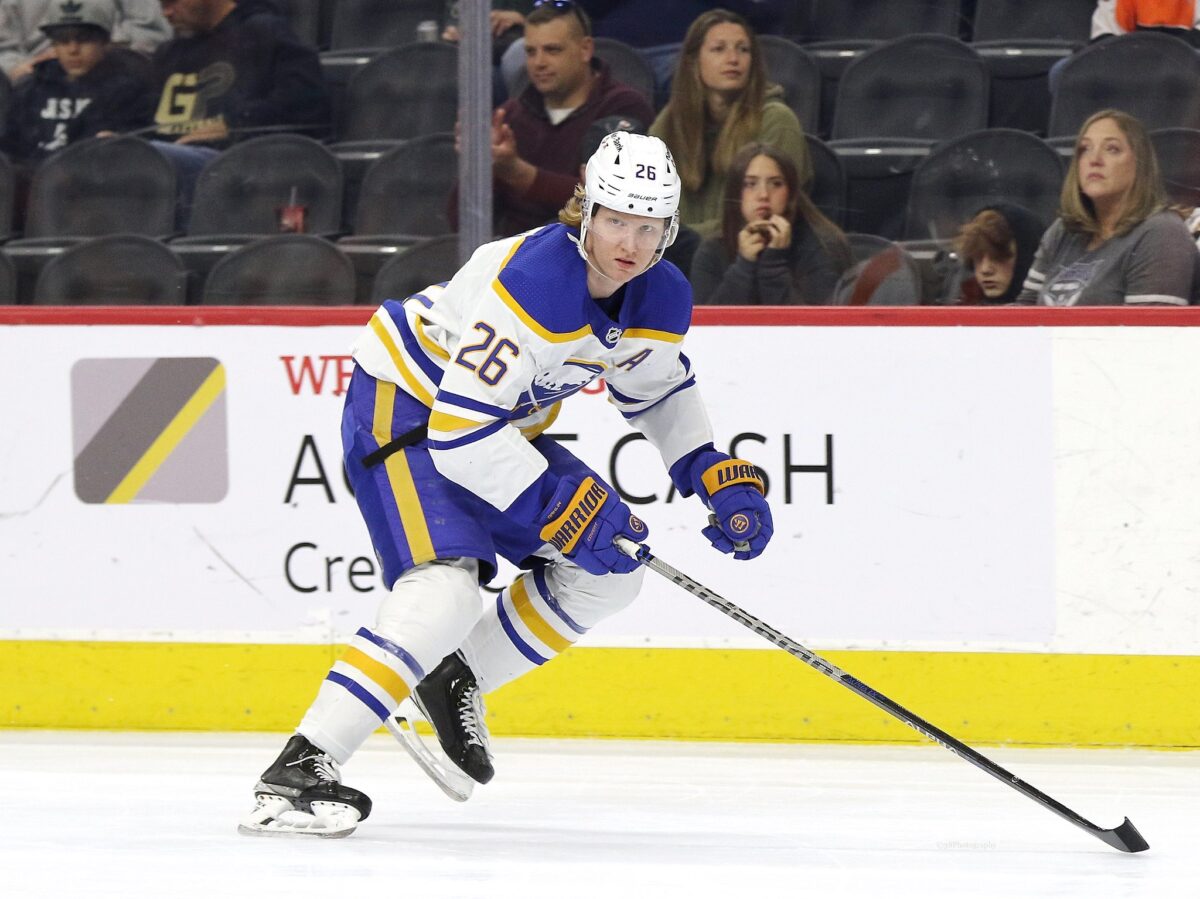On Sunday, NHL Network released its picks for the top-20 defencemen in the NHL going into the 2022-23 season. Guess what? Vancouver Canucks star Quinn Hughes was on it – ranked 12th ahead of Brent Burns, Alex Pietrangelo, Rasmus Dahlin, Drew Doughty, Zach Werenski, Shea Theodore, Morgan Rielly and Jaccob Slavin. Finally, after being a standout in Vancouver ever since he was drafted, he’s getting some recognition as a top-flight defenceman in the NHL from writers and analysts that are not based in the Western Conference.
Related: 3 Canucks Who Could Be X-Factors in 2022-23
Except that’s not the biggest development to come out of these rankings. No, that would be the fact that Hughes was ranked six spots ahead of Dahlin – the man that was drafted first overall by the Buffalo Sabres in 2018, the same draft Hughes went seventh to the Canucks.
History Has Shown Canucks Actually Won the Draft Lottery in 2017 & 2018
Despite all the “bad luck” the Canucks have had with the Draft Lottery over the years, they have actually come away with some great consolation prizes – namely Hughes (2018) and Elias Pettersson (2017). It could be argued that they won the lottery in both years as Hughes has become a legitimate top-pairing NHL defenceman and Pettersson a superstar – even though general manager Patrik Allvin seems to disagree.

While Pettersson would not have been the first overall pick in his draft year – that would obviously be Cale Makar – Hughes definitely can make a case as most teams would probably choose him over Dahlin at this point. I would argue even ahead of Andrei Svechnikov and Brady Tkachuk since top-pairing defencemen like Hughes don’t come around every day. Most of the time, you have to draft them as trading for them in their prime would cost an arm and a leg.
Bottom line is, that the Canucks found some good luck in those years even though it didn’t feel like it when the lottery balls finished falling. If you need some proof, just look at the numbers: Hughes leads all defencemen drafted in 2018 with 19 goals and 165 points in 205 games and is the third-most productive pick behind only Tkachuk (192 points) and Svechnikov (209 points). As for Pettersson, he leads all 2017 picks with 97 goals and 221 points, 15 points ahead of the first-overall pick Nico Hischier all while playing 55 fewer games. I think it’s safe to say that the Vegas odds were in favour of the Canucks instead of against them.
Comparing Hughes & Dahlin’s Development Since Their Debuts in the NHL
But back to Hughes and why he should have been selected ahead of Filip Zadina, Barrett Hayton, Tkachuk, Jesperi Kotkaniemi, Svechnikov, and most of all, Dahlin. First, let’s take a look at Hughes and Dahlin’s progression from when they made their NHL debuts during the 2018-19 season to now.
| Player | GP | Goals | Assists | Points | Average TOI |
|---|---|---|---|---|---|
| Quinn Hughes | 205 | 19 | 146 | 165 | 23:17 |
| Rasmus Dahlin | 277 | 31 | 129 | 160 | 21:41 |
Looking solely at the stats, it appears that both defencemen are very similar in their development so far. However, Hughes’ 165 points were recorded in 72 fewer games, which, if projected over the same amount Dahlin has played so far, would add approximately 60 more points to that total. As a result, Hughes would actually have 225 points – all things being equal that is.

While I am not saying that Hughes is astronomically better, I believe his overall ceiling is higher than Dahlin’s. Yes, Dahlin will always have the 6-foot-3, 207-pound size advantage over Hughes’ 5-foot-10, 175-pound stature, but in a league now led by an undersized blueliner in Stanley Cup, Conn Smythe, Norris and Calder Trophy winner Cale Makar, Hughes has become much more relevant as a high-powered top-pairing option.
Related: Canucks’ Potential 2022-23 Opening Night Lineup
What’s more, after struggling defensively in his sophomore season and finishing with an underwhelming minus-24 in the plus/minus column, Hughes has started to show signs of becoming a two-way force like the aforementioned Makar. Dahlin, on the other hand, is still having problems in that respect – despite hitting career highs across the board in 2021-22 with 13 goals and 53 points, his best since 2019-20.
Hughes & Dahlin’s Progression Into a Two-Way Monster Like Makar
Hughes is also further along than Dahlin in transforming into what Makar is for the Colorado Avalanche, as 2021-22 became his coming out party both offensively and defensively. Finishing with not only a personal career-high with 68 points, but he also broke a franchise record for points in a season by a defenceman that had held up since 1986-87 when former assistant coach Doug Lidster recorded 63 on the strength of 12 goals and 51 assists.

Defensively, Hughes cut down on the giveaways, increased his takeaways and finished with his first plus-rating in the plus/minus column at plus-10. He also continued to dominate the possession metrics with a 57.8 Corsi-for percentage (CF%) in all situations and a 53.7 CF% at 5-on-5. Comparatively, Dahlin recorded the most giveaways since his rookie season, was still in the red with a minus-21 and finished with the worst CF% of his career so far. Clearly, he still has more work to do defensively.
On special teams, both defenders excel on the power play as Hughes has 79 power play points to Dahlin’s 71. The biggest difference between the two is the number of goals, as Hughes only has three (all scored in 2019-20) while Dahlin has 11. There are some positives to that stat though, as all eight of his goals last season came at even strength, which is actually more impressive considering there is a lot less space on the ice to showcase his talent.
Related: Pick One Vancouver Canuck: Elias Pettersson or Quinn Hughes
When it comes to the penalty kill, Hughes rarely, if ever, saw the ice when his team was shorthanded – that is until Bruce Boudreau took over behind the bench in December of 2021. Having approached his new head coach with a request to join the penalty-killing unit, he began to see regular minutes there and surprisingly excelled. Logging an average of 1:42 shorthanded, he used his quick stick and tremendous skating to get his team out of trouble more often than not.
Yes, the Canucks finished 30th on the penalty kill in 2021-22, but that was mostly the result of a bad run pre-Boudreau. If you look at the post-Boudreau numbers, they were just outside the top 10 with an 80.8 percent kill rate after Dec. 6, 2021. I choose to believe that Hughes had something to do with that. As for Dahlin, he was not a primary contributor to the penalty kill as he only saw the ice for an average of 0:55.
Canucks Got the Best Defenceman of the 2018 Draft
All in all, Hughes has seen more of a progression into a two-way defenceman like Makar to this point of his development. That in my mind adds more ammunition to the argument that he should have been drafted ahead of Dahlin and that the Canucks got the best defenceman of the 2018 Draft. No, he might not hit the heights of Makar – who also wasn’t selected first – but he’s got the silky-smooth skating, edges, hockey IQ, offensive instincts and now, defensive acumen to potentially do it in the years to come. That should be music to every Canucks fan’s ears, as they continue to hope and pray for a Stanley Cup with Hughes’ capable hands at the helm.
All stats were taken from Hockey Reference and NHL.com